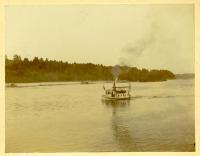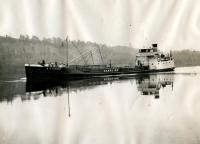
Della Collins, Eastern Steamship Company Wharf, Kennebec River, Hallowell, ca. 1890
Hubbard Free Library
The Zebedee E. Cliff was a schooner that had competition from steam-powered freighters during the Great Depression.
In 1941, the "Zebedee E. Cliff" and the "Maude M. Morey" had been towed to Portland for repair. Both boats were bought by the government, hauled into the Casco Bay, and sank in the harbor as protection of enemy subs.
The Governor King was recruited during the Centennial of Statehood gathering on August 1, 1920. It was named in honor of Maine's first governor of Maine, William King. This steamer was built in 1902 in New York for the Port Chester service. Then it was purchased for the use at Bath to help the smaller Hockomock ferry.
Thomas Coss was the first to captain of the Governor King. It was built for the coastal trade, and the steamer’s cargo was mostly coal. She stranded on Ocracoke, North Carolina, in 1913, and was lost. Schooners were used to carrying cargo in a lot of different environments from ocean trips to coastal runs and on large inland bodies of water.

Steamer, Lizzie M. Snow, Kennebec River, Hallowell, ca. 1905
Hubbard Free Library
They were popular in North America, and in their heyday during the late 19th century over 2,000 schooners carried cargo back and forth across the Great Lakes.
Three-masted "terns" were a favorite rig of Canada's Maritime Provinces. The scow schooner, which used a schooner rig on a flat-bottomed, blunt-ended scow hull, was popular in North America for coastal and river transport. They could go from Hallowell to as far away as Cuba.

Last Tanker, Kennebec River, 1966
Hubbard Free Library